How to Control Plant Pests (Spider Mites & Whiteflies)
If you have a garden or houseplants, pests will appear. Here’s a guide on how to control plant pests. Plus you’ll learn how to identify spider mites and whiteflies so you can take action.
Even though you might keep your garden or houseplants well-tended, pests can seemingly appear out of nowhere. What’s up with that? This is why it’s important to know what’s attacking your plants with proper ID and then spring into action. Last week I covered aphids and mealybugs. This is all about spider mites and whiteflies and how to control them.
Note: This post was published on 4/15/2017. It is now 2023. It’s one of the early posts that I wrote. My, how blogging has changed!
We’ve since written more posts on Plant Pests. Rather than do an extensive update on this one, I’m just going to list the more current posts right below, and you can refer to those for more information: How To Get Rid Of Spider Mites On Plants, Whiteflies On Plants: Indoor & Garden Control, How To Get Rid Of Aphids, & Mealybugs On Plants.
What Are Spider Mites and Whiteflies?
Both spider mites and whiteflies are soft-bodied, sucking insects.
They slowly suck the sap out of a plant which over time weakens it, stunts the growth and deforms the flower. You can liken sap in plants to blood in animals. The sap contains sugar which these pests love, as do ants who in turn flock to an infested plant.
Spider Mites
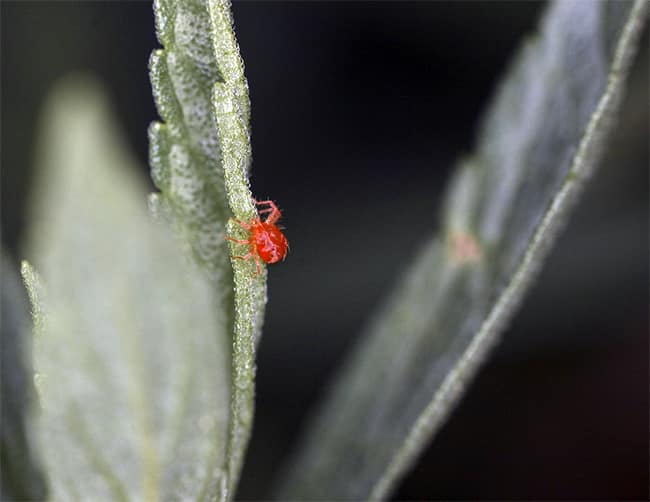
Here’s a red spider mite close up. You’d need a magnifying glass to see it.
Spider mites are hard to identify until the damage is already done, because they’re so tiny. They’re difficult to see without a magnifying glass but can be red, greenish or light brown. If you think your plant is infested with them, just put a piece of light colored paper under the leaf and tap, tap, tap. When little specks fall onto the paper, then you can i.d. them.
Spider mites are actually related to spiders. They generally hang out on the undersides of the leaves. If you see the leaves yellowing, mottling, specking and eventually turning brown, then the infestation is getting bad. The leaves will fall off and webbing (usually at the top where the new growth is) will appear when things are getting really bad. When it reaches this stage, it’s hard to bring the plant back to health.
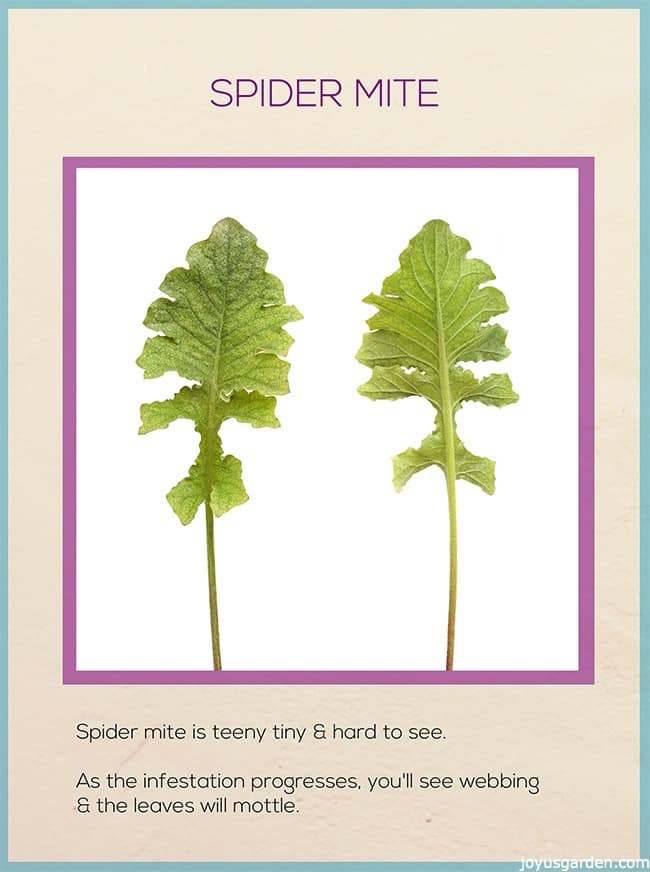
Spider mites breed like crazy
So, if you have houseplants, be sure to check them for spider mites at that time of year. If you prefer to grow your own, keep your eyes open for spider mites (as well as thrips) infesting pot.
Whiteflies
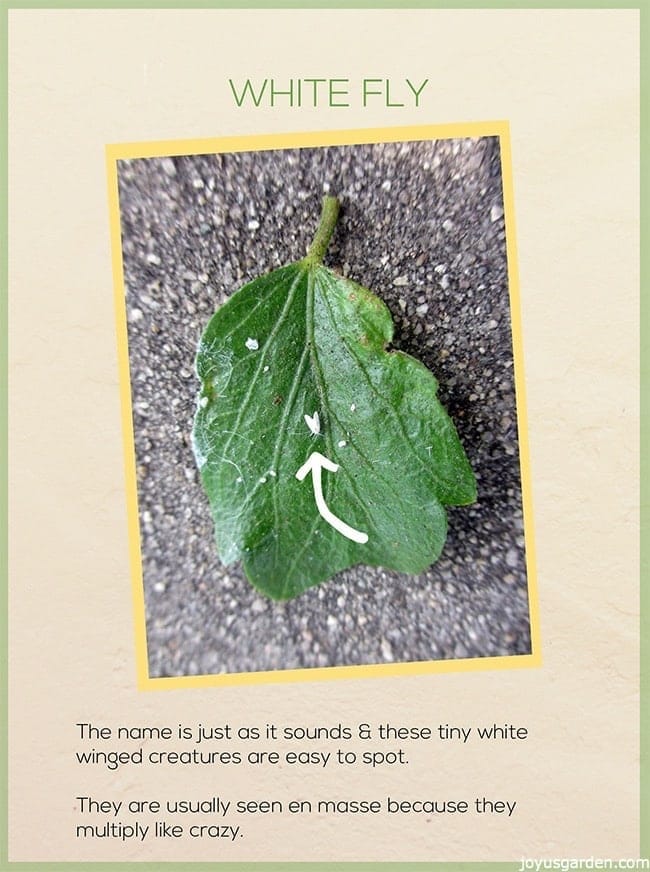
Whiteflies on the other hand, are very easy to spot and i.d. They’re small (but big enough to see), white and fly off when you touch a plant. It’s actually the adults that fly and that’s what makes them hard to control. At juvenile stage they just hang out on the under sides of the leaves.
Whiteflies, like aphids and mealy bugs, secrete sugar that they can’t ingest when sucking the sap. This causes the leaves to get sticky. You might see a black mold forming and that’s actually a fungus which grows on the sugar
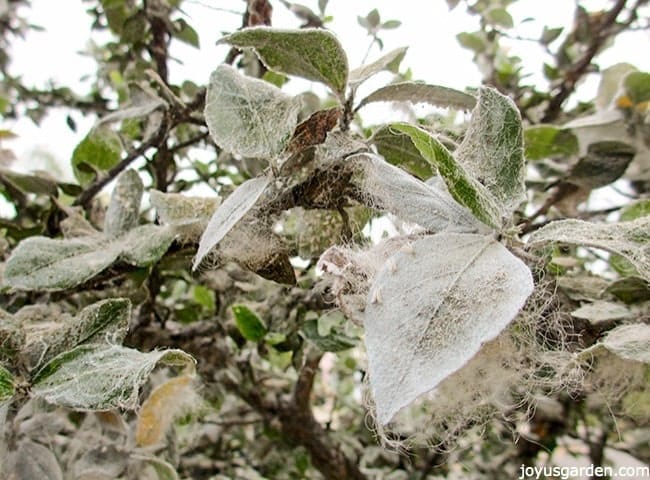
A bad infestation of white flies on Hibiscus. Here you can see the cotton threading I was talking about.
When the infestation worsens, you’ll see white cottony threading appear on the undersides and edges of the leaves. There was a row of hibiscus trees along the sidewalk in Santa Barbara which looked like they were coated with snow in August. They were stressed from lack of water and would always get a bad infestation of whiteflies. The leaves looked like they were edged with white cotton candy!
Besides on hibiscus, whiteflies are commonly seen in greenhouses and on tomatoes and flowering plants.
How To Control Spider Mites and Whiteflies
1) Release predators like ladybugs.
Release ladybugs or lacewings in your garden as a method of control. Lacewings devour soft-bodied insects much faster than do ladybugs. This obviously isn’t a viable solution for your houseplants! There is a predatory mite which control spider mites & a whitefly predator for the whiteflies. Both eat the eggs which is a good way to prevent future infestations.
2) Spray with water using the garden hose, kitchen or bath spray.
This is the method I fall back on. You want to gently blast off (no fire hose action here please) the pests & their eggs. The spray in your kitchen or bathroom will be suitable for your houseplants if you don’t have access to a hose outdoors. For these 2 pests, this method is a partial control. You’ll get the many of the adult spider mites & their eggs, but it’ll only work for getting the juvenile whiteflies & the eggs.
3) Insect killer sprays.
I don’t use chemicals so these listed are considered to be “natural controls”. They include: horticultural oil, insecticidal soap & need oil. Most plants can be sprayed with these but just check first. You can do a little research & see which would best for you.
Here are some options: insecticidal soap ready to use, insecticidal soap concentrate, horticultural oil ready to use, horticultural oil concentrate, neem oil ready to spray & neem oil concentrate. This 1 lists itself as a houseplant & garden insect killer.
4) Homemade spray recipes.
Here’s the way I’ve always made an soap/oil spray: Mix 1 tablespoon mild dish soap or Dr. Bronner’s, 1 tablespoon vegetable oil & 1 cup water. This works for a mild infestations of whiteflies although the adults will fly away.
Here’s what I’ve used to control a mild infestation of spider mites: Mix 1/8 cup apple cider vinegar (white vinegar is fine too) with 1 cup of water, 1/2 t of baking soda & a few drops of mild dish soap into a spray bottle. This is more of a deterrent & should be used on or around established landscape plants only.
Rodale’s, a source for living naturally which I’ve known about & respected for a long time, has a recipe for this natural pest spray with garlic, onion & cayenne pepper.
5) Sticky Traps
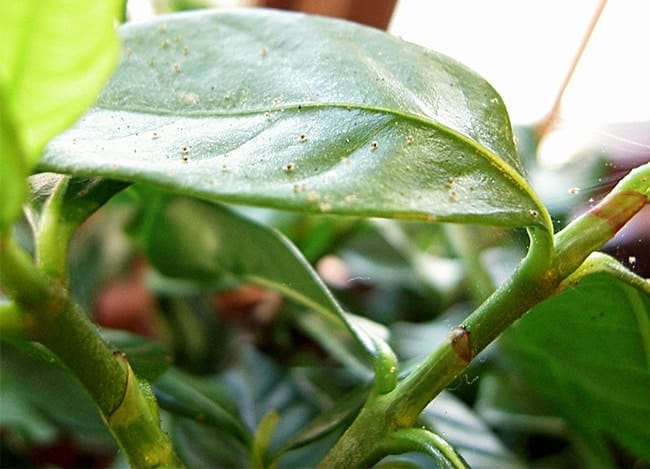
I used sticky yellow traps to get the adult whiteflies. Hang them in or right next to the infested plants. The color yellow attracts whiteflies. They’ll fly right into the sticky traps.
What You Need to Know About Spider Mites and Whiteflies
Whiteflies & spider mites can be found on the undersides of the leaves. They both have soft bodies so they’re easy to control if you catch them in the early stages. So, control these pests as soon as you see them. Once the infestation gets bad, they’re hard to get rid of. Your plant may not recover. This is especially true of a spider mite infestation.
* Ants are after the sugary residue left behind by the whiteflies. The ants will disperse once the insects are gone.
* The leaves of the plant can get sticky – that’s caused by the sugar secretion. You might see a black residue (the fungus) appear – you’ll want to get rid of that too.
* If you choose to spray as your method of control, you’ll need to repeat. Follow the instructions on the bottle as to how often. A homemade spray you can repeat every 7 days. It might take 3-4 rounds to control the pests. Make sure the plant isn’t stressed (ie bone dry) before spraying. And, don’t spray in the hot sun.
It’s very, very, very important to spray the undersides of the leaves thoroughly.
That’s where these pests hang out. Be sure to inspect any new plants you bring home to make sure they’re not carrying any pests. The same goes for plants which have summered outdoors. Check them for pests before bringing them in for the colder months.
Hopefully, your plants never get spider mites or whiteflies, but if they do, now you can identify them and take action.
Be sure to check out these other pest posts: aphids & mealybugs as well as scale & thrips.
Happy (pest free) gardening & thanks for stopping by,

You May Also Enjoy:
Plant Pests: Scale & Thrips & How To Control Them
How To Control Plant Pests: Fungus Gnats & Root Mealybugs
Lucky Bamboo & Spider Mites: How To Control This Common Plant Pest

This post may contain affiliate links, you can read our policies here.
- About the Author
- Latest Posts
Nell, the founder of Joy Us garden, was born into a gardening family and grew up in Connecticut’s countryside. After living in Boston, New York, San Francisco, & Santa Barbara, she now calls the Arizona desert home. She studied horticulture & garden design, working in the field all her life. Nell is a gardener, designer, blogger, Youtube creator, & author. She’s been gardening for a very long time & wants to share what she’s learned with you.




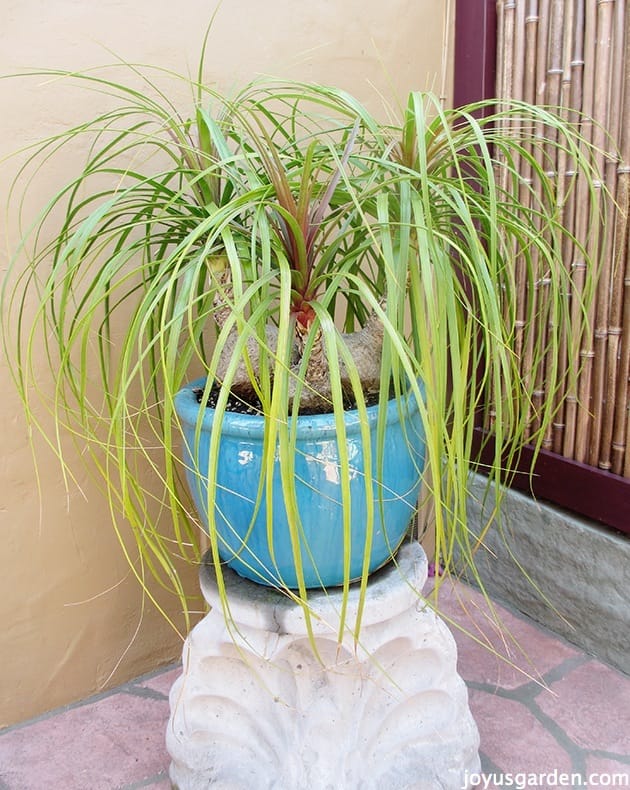

I watched your presentation about whiteflies and spider mites. Thank U for posting.
My hisbicus plant had beautiful flowers that were 7 1/2 inches wide but I had to let it go because it was impossible for me to control the whiteflies and it probably had spider mites as well. Now it is quite difficult to find this pale yellow plant. It was very beautiful when it was young. First of all the colour of the flowers were cream and as the plant got older it was pale yellow and finally medium yellow. Had this plant for over 15 years and
it was a joy to have.
Hi there,
I bought a white bird of paradise plant a week ago and didnt realize it was infested with white flies. I caught it in time and used dishsoap and teatree oil and wiped over and under the leave and the stems as well . I wanted to know should I discard the soil it is in . right now when I decide to repot it and can that white fly infect my other plants
Thanks
nazra
Yes Nazra, whiteflies can infest your other plants. They like the foliage & stems, not the soil. Some of the larvae can fall in the soil but it’s usually not an issue. Remove the top 1″ or 2 of soil if you’re concerned. Nell
Hi Frances – Spider mites, mealybugs & especially whiteflies love hibiscus! Too bad yours succumbed. You can beat them for those big, beautiful flowers. Nell